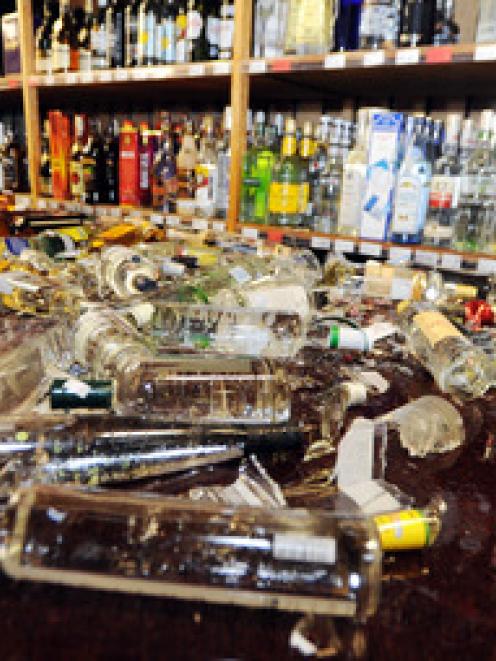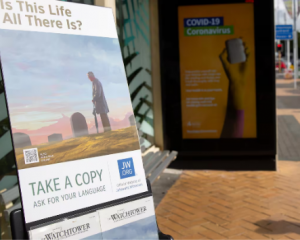
Engineers have spent the day assessing thousands of buildings in the CBD and have found 35 sustained damage.
Mayor Celia Wade-Brown said damage was mostly minor and no structural damage had been discovered.
This opened the way for businesses and organisations to reopen and workers and shoppers to return to the city, she told a press conference this afternoon.
The magnitude 6.5 quake, which struck in the Cook Strait just after 5pm yesterday, shattered windows, damaged facades, cracked a road and caused reclaimed waterfront land to fall into the harbour.
GNS Science seismologist Ken Gledhill said it was a "one in several decade event".
He said it was one tenth of the size of the Christchurch quake, which decimated its central city.
There have been more than 100 aftershocks since the tremor, which Dr Gledhill said was "normal".
"This is not unusual behaviour for the Cook Strait region. It's following the pattern we would expect."
Prime Minister John Key says there has been minimal damage to infrastructure and assured quake-hit Wellingtonians the Government would do its "very best" to ensure they get the support they needed.
Mr Key was still to get an update on any fiscal impact of yesterday's earthquake but said, in principle, New Zealand could afford to pay for the damage caused by another earthquake.
"There's nothing at the moment that's been advised to me that would indicate there's substantial fiscal risk to the Crown, we know that the Earthquake Commission fund really has nothing in it from the last time I looked at it.
"The Government just backs that up anyway, we have a strong balance sheet - we're in a much better shape than pretty much any OECD country in the event that we need to rely on the Crown," Mr Key said.
Yesterday's quake was the third "significant" tremor since Friday morning, GNS Science says.
More than 100 aftershocks have rattled the area, including a 4.9 jolt just before 11am today.
GNS has also predicted there is a 30 per cent chance of an aftershock measuring up to 6 in magnitude in the coming week.
Numerous buildings have closed around the city, including the Greater Regional Council, the NZ Post building, and the national museum, Te Papa.
A number of roads in the city were still closed this afternoon as glass and debris is cleared from the streets and engineers continue their visual assessment of the buildings.
Mayor Celia Wade-Brown has advised workers to stay away from the CBD for the rest of the day, but expected people should be able to return to work in the next few days.
The earthquake was not on the same scale as the Christchurch quake, which was "high energy" and much deeper, she said.
"Yes we have to be careful, but it's not a matter of closing the city."
Medical emergency services had very few callouts following the quake, but emergency services are bracing in case another large one hits.
There have been four reports of people needing medical care following the 6.5 tremor, but no serious injuries were suffered.
Wellington Free Ambulance (WFA) spokesman Daniel Paul said one person was injured when a television fell on them, another was shaken out of bed and a couple more suffered anxiety chest pains.
Trains in and out of the capital were halted after the quake so tracks could be assessed and a decision would be made this afternoon as to when they would be back up and running, a KiwiRail spokeswoman said.
Meanwhile, Seddon residents, near the epicentre of the quake have been told to boil their drinking water, Radio New Zealand reported.
Many people fled the area last night, going to Blenheim or Picton, to escape the worst of the aftershocks.
Quakes may last for weeks
A swarm of earthquakes that rocked New Zealand and caused damage and shattered nerves in the Wellington region may carry on for weeks.
The biggest jolt - of magnitude 6.5 and centred in Seddon, 25km from Blenheim - rattled Wellington just after 5pm, causing damage around the capital. It was also felt as far away as Auckland and Canterbury.
Terrified residents ran for cover during the long shake, which blew out windows, cracked concrete and caused buildings to sway.
In many areas the contents of shelves in homes and shops came crashing to the ground. At least four people were believed to be injured, though none seriously.
As aftershocks continued well into the night, including one measuring 5 just before 8.30 25km east of Seddon, cordons were being put up and roads, including Featherston St in central Wellington, were closed following concerns about building stability and the possibility of sinkholes appearing.
Wellingtonians who worked in the central city were also being advised to stay home today while the extent of the damage is assessed.
April Ferrino was in a fifth-floor apartment on Lambton Quay when the big quake hit.
"I'm from Austin, Texas, so we're used to other natural disasters - tornadoes, hurricanes. Earthquakes are extremely terrifying because you can't predict them.
"Things started falling off the shelves. It was terrifying. I felt the first tremor this morning, which was a slow rumbling ... but this one was a jolt. It was extremely terrifying."
Around the city, several buildings were evacuated after reports of structural damage. At the Mercure Hotel, 76 people were led to safety after the sixth floor partially collapsed.
A police officer at the scene said the building had dropped up to 50mm in the stairwell on the southern side. Police had also moved 140 people from a building behind the hotel and 50 from nearby student accommodation because of fears for the Mercure's "potential collapse".
About 100 people, including Ahmed Bhari, his wife Azreen and young son Eadayat, were evacuated from The Aitken on Mulgrave apartment block due to extensive flooding.
"It was very scary," Mr Bhari said, "and now my family have moved to a motel for two nights. It really shook, so it was very scary."
Nelson Fernandes, 44, returned to his flat to find it already evacuated.
"There was a major water leak and the whole apartment, seven levels, got cleared out," he said. "It's terrible.
"There was one cafe down below that was totally damaged. It was soaking, all the floors; we had tiles falling off the roof. There is so much damage it is absolutely terrible. I have never felt anything like that."
A burst pipe flooded the Central on Willis apartment of Sunny Gupta, aged 26.
"It burst on my level, level eight, and the whole apartment was full of water and we actually had to take our pants off and run through the leaking stuff."
The water spread right down to the ground floor and residents were asked to find other accommodation.
The software engineer spoke of cracks on the walls and fallen roof tiles. Crockery and electronics had smashed. "It was very, very scary."
Sarah Bennett, who lives in a hilltop house, said it was the worst quake she had felt. "You usually only get a bit of a jiggle, but this was a hula dance," she said.
The CBD was temporarily locked down after streets were littered with glass from broken windows. Workers kept people away in case another quake struck and loosened the glass that was left.
The city's library was thrown into disarray as hundreds of books hurtled from the shelves onto the floor, and at the port, a large crack appeared in the concrete.
Wellington Maritime Police senior launch master Barry Hart said about 5m of reclaimed land had subsided into the sea at Thorndon Container Terminal, taking with it a large container and a buoy larger than a truck.
Mr Hart was aboard the police launch at the time of the quake and said there was "an awful lot of loose objects floating on the water".
"We immediately went further out to sea to immunise ourselves if there was a tsunami; secondly to offer assistance to any boat if there was any difficulty.
"Immediately upon travelling into Lambton Harbour we saw a significant part of what's known as the container terminal ... had subsided into the water. And one shipping container, as well as quite a bit of other product that had been stored, was in the water or on the edge."
A flotation boom was put around the debris to prevent a collision and the harbourmaster was to inspect the damage this morning.
"The scale of this event is growing as the day goes on," Mr Hart said. "They're finding more and more buildings in the central city that they have doubts about the structural integrity of so we're slowly expanding the cordons out further and further.
"If you were to walk through the city you'd see a bit of broken glass on the ground ... Other than that you would think, 'Gosh, the city's escaped really well.' But it's not until you get into these buildings you discover cracks in stairwells and other things that there is real concern about."
Within minutes of the 6.5 quake, emergency services were inundated with 111 calls.
One man was knocked out and received minor injuries after a television fell and another person attached to a medical machine was treated by ambulance staff after being shaken out of bed. Two people were treated in hospital for minor injuries.
The St John communications centre also received a number of calls from people with chest pains and anxiety, although nothing life-threatening.
At Hutt Hospital, a section of ceiling collapsed in the third floor of the community health building and four people were evacuated.
Power was cut during the quakes to 3500 homes but restored within an hour.
Wellington Airport was temporarily closed while a runway check was carried out. All suburban trains were cancelled until further notice and KiwiRail said there would be no bus replacements.
Victoria University authorities said the campus would be shut today.
The jolt followed a number of earlier quakes, also centred in Seddon. A series of smaller but intense tremors were also recorded elsewhere, including one in Waverley and another near Hanmer Springs in North Canterbury.
The faultline causing the quakes has a history of producing "swarms" and Victoria University professor of geophysics Euan Smith said it was likely the current swarm would continue for some time.
He said yesterday's seismic activity was similar to a swarm of 30 smaller earthquakes which struck Wellington in January 1950.
"They could go on, as the 1950 swarm did for a month. Or they could be all over, though I think that's very unlikely," he said.
Marianne Aitken, spokeswoman for the Marlborough District Council, said Seddon had had no power since the earthquake.
Chrissie Small, from Blenheim, said she suffered motion sickness during the big tremor.
"Seems there's a quake every four minutes at the moment but they're small ones ... Poor Seddon is bearing the brunt ... I hope it's nearing its end."
An evacuation centre was set up at the Awatere Rugby Club in Seddon and some people gathered there last night.
A police spokesman there had been some damage and landslips in Seddon township.
People in Napier reported the earthquake as a long shaking, while Gisborne woman Jennifer Cockayne felt it as a rolling sort of quake that seemed "like a wobble rather than a shunt" which left her with an uncomfortable feeling.
Some as far north as Auckland felt the rocking. Manoj Bangia was sitting with friends in a Pakuranga living room when the house started shaking. "We all felt our heads dizzy. [It] lasted for 10 to 20 seconds before we came out of the house."
A couple on the 26th floor at the Metropolis apartments in Auckland's CBD said they also felt the quake as their building started creaking. At first, they thought it was the wind, but because it was a still night they assumed it was an earthquake.
In Canterbury, a resident described the quake as a "lazy roller" that rattled the nerves.
In New Plymouth, Michael Riley said: "It was the biggest earthquake I have ever felt."












